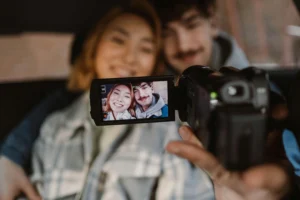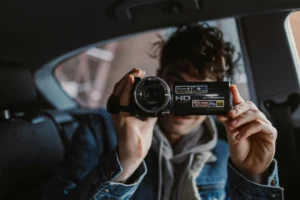What is the best Camcorder for filmmaking?
An All-Inclusive Handbook
Having the correct tools is just as important in the ever-changing realm of filmmaking as having a gripping narrative. Even if cellphones and DSLRs have advanced, camcorders are still a dependable and effective instrument for directors, especially those trying to strike a mix of performance, usability, and cost. If you take cinematic storytelling seriously, you most likely wonder: Which Camcorder is ideal for filmmaking?
This guide divides the main characteristics to search for, top models worth your money, and advice to help you choose the best Camcorder for your artistic requirements.
Why should one choose a camcorder for filmmaking?
Documentary filmmakers, YouTubers, independent filmmakers, and even students starting their careers in video production use camcorders, especially for the purpose of shooting video. Here’s the reason many still choose camcorders over DSLRs or mirrorless cameras:
- Longer constant recording periods, free from overheating
- Improved built-in audio recording features
- Ergonomic design tailored for portable video capture
- ND filters are included in an optical zoom.
- Simplified storage and file handling
Looking for a Filmmaking Camcorder?
Before diving into particular models, one should be aware of the main characteristics defining a good camcorder for filming:
- Considers frame rate and video resolution
The standard currently is 4K resolution for cinematic quality. While ideally you should aim for 4K at 24fps or 30fps, and higher frame rates like 60fps for slow-motion recording, look for camcorders offering at least 1080p (Full HD).
- Sensor Proportional Size
Greater low-light performance and a more cinematic depth of field come from larger sensors capturing more light and information. For a professionally looking video, search for 1-inch sensors or greater.
- Manual Restraints
Full creative power comes from having hand controls for white balance, focus, and exposure. Search for camcorders with conveniently accessible adjustable buttons and dials.
- Audio Reference
Excellent audio is really essential. Make sure the Camcorder has a 3.5mm mic connector or XLR inputs, and preferably headphones for sound monitoring.
- Balancing
Especially when handled, built-in optical image stabilization (OIS) or powerful electronic stabilization helps lower shaking.
- Media support and battery life
Long runs rely on consistent battery life. Additionally, find out whether the camera offers twin memory card slots for longer recording.
Top 5 Camcorders for Filmmaking in 2025
- Canon XA60 Best for semi-professionals and content producers
- 4K UHD 30p recording with a 1/2.3-inch CMOS sensor
- Professional audio uses dual XLR inputs.
- Small, light body
- Excellent optical 20x range of zoom.
Why it’s great: It’s perfect for YouTube production and documentary-style filming as it strikes a mix between cost and pro-level features.
- Sony FDR-AX700 Ideal for single filmmakers
- 1-inch CMOS sensor placed one inch apart
- 4K HDR (HLG) capture
- Quick hybrid autofocus
- S-Log3 for varying color grading range
Why is this fantastic? It provides capabilities usually seen in more expensive cameras and shows better picture quality in many lighting situations.
- Panasonic HC-X1 is Ideal for filmmakers working professionally
- MOS sensor one inch in size
- DCI 24p 4K and UHD 60p
- Twenty times an optical zoom lens
- Dual SD card slots
Why it’s great: It offers a large dynamic range and superb detail, therefore meeting everything you would require for commercial and film projects.
- Blackmagic URSA Mini Pro 12K—alternative choice
Ideal for cinematic photography (not a camcorder but near).
- Superior 35 sensor
- 12K resolution for the Shoots
- Raw and ProRes forms
- A wide range of choices for connection
Why is this list item on here? Although not a camcorder in the conventional sense, the URSA Mini Pro is ideal for high-end events where first quality is absolutely required.
- JVC Gy-HM250U
- Perfect for DIY filming with live streaming.
- 4K Ultra HD footage
- Ability for integrated live streaming
- Designed graphics overlay (perfect for vlogs or news)
- Two XLR outputs
Why it’s great: It provides strong adaptability for independent filmmakers who also want to generate web video content or live broadcast.
Advice on Selecting a Camcorder
- Sort your style: Different demands abound in narrative films, documentaries, YouTube videos, and other media.
- Regarding post-production, increased editing freedom is made possible by higher bitrates and codecs such as ProRes or RAW.
- Don’t overspend: Beginning filmmakers will find more than enough in entry-level 4K cameras.
- Try before you make purchases: If at all feasible, rent or test the Camcorder before investing long term.
Final Verdict: Which Camcorder Shows Greatest Performance?
Every filmmaker will find no one “best” Camcorder. Rather, it will rely on your project type, degree of expertise, and financial situation.
- The Sony FDR-AX700 is the ideal all-rounder for most solo filmmakers and multimedia producers if you’re searching for one. Should you be starting professional-level production, the Panasonic HC-X1 or Canon XA60 is an excellent long-term investment.
- Great tales, meanwhile, originate from creative minds, not just from pricey tools. Choose a camcorder that simplifies rather than one that improves your process.

Five Questions About Filmmaking Camcorders
1. For video, do camcorders outperform DSLRs?
Long-form video filming calls for camcorders, which also have built-in stabilization, extended recording durations, and improved audio integration. Nevertheless, DSLRs/mirrorless cameras provide better picture quality and versatility when it comes to lens choice. The best decision will rely on your priorities.
2. Does filmmaking call for 4K?
Not exactly, but it is rather advised. Like cropping and stabilizing, 4K provides versatility in post-production and crisper video. Shooting in 4K may improve production quality even if your ultimate output is 1080p.
3. Is it possible to get cinematic footage using a camcorder?
Yes. Although many more recent versions (such as those with 1-inch sensors) provide lower depth of vision, wider dynamic range, and manual control—key components of a cinematic look—camcorders have historically used smaller sensors.
4. Given that built-in audio on the Camcorder, is a microphone required?
Yes. Many times lacking depth and picking up handling noise, built-in mics Sound quality is much enhanced with a shotgun mic or lavalier mic hooked into a 3.5mm or XLR input.
5. For novices, which Camcorder is best?
Perfect for beginning filmmakers who desire space to expand, the Canon XA60 and Sony FDR-AX43—a cheaper edition of the AX700—are both user-friendly and loaded with capabilities.
Conclusion
Although camcorders may not be as popular as mirrorless cameras or cellphones, they are very consistent in dependability and high-quality video output. There is a camcorder out there ready to help you realize your idea, regardless of your level of experience—beginner, YouTuber, or professional director.
